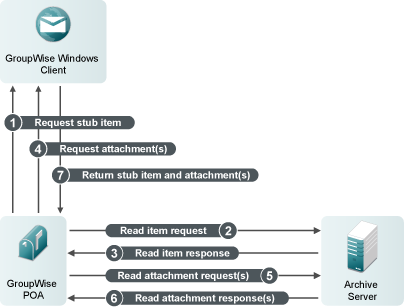1.1 Stubbing Overview
GroupWise stubbing allows a GroupWise Windows client to directly access third-party archive items.
A stub is an archived item, where all the attachments (files, distribution lists, message body) have been removed from the GroupWise store and placed into a third-party store. The archive server communicates with the POA to create a stub.
Figure 1-1 Creating a Stub Item

For more information, see Section 1.1.2, Create.
-
The archive server logs in to the POA to create a stub for an archived item.
-
The archive server transfers all item content into its archive store.
-
The POA provides the original message ID as the ID for the archived content.
-
If needed, the archive server can restore the item content by replacing the stub with the original item.
When a GroupWise client user requests the information from a stubbed item, the POA sends a request to the archive server requesting the stubbed information.
Figure 1-2 Example of a Stub Item Request

-
When a GroupWise user wants to view an item that has been stubbed, the GroupWise client requests the item from the POA.
-
The POA requests the item from the archive server.
-
The archive server returns initial item content including the distribution list.
-
When the GroupWise client receives the initial item content, it requests item attachments.
The message body text is an attachment, as well as any files that the item sender attached.
-
The POA requests the attachments from the archive server.
-
The archive server returns the attachments (item message body and pointers to any files that the sender attached).
If any attachment is larger than 32K, multiple requests and responses are required to deliver the attachment.
The content of attached files is not returned unless the GroupWise user views the attachment.
-
The POA delivers the item to the GroupWise client for viewing.
For more information, see Section 1.1.3, Read.
The administrator must enable stubbing in ConsoleOne before it can be used. For more information see Section 1.2, Enabling Stubbing on a POA.
1.1.1 Login
Prior to the POA sending any requests to the archive server, a session must be established with the archive server by sending a loginRequest SOAP command to the archive server. This establishes a session (denoted by a session key) that is used by the remainder of the commands.
1.1.2 Create
Stubs are created by the archive server through the stubItemRequest SOAP interface call. A stub is not the same item as the original item. The original item is deleted and replaced by the stub. The stub retains the original GroupWise message ID that it had before it was stubbed. A stubbed item has a flag denoting a stubbed item. Each stubbed item is identified with a unique icon in the GroupWise client.
Only the GroupWise Windows client supports opening stubbed items. They cannot be opened in GroupWise WebAccess.
1.1.3 Read
When a user clicks an item in the Windows client to open the item, the Windows client sends a request to the POA to read the item. The POA sends a readItemRequest SOAP request to the archive server to return the original item data in a readItemResponse SOAP response.
The original item data is returned with the exception of the attachment data. The SOAP response returns information regarding the attachments, but the Windows client must to perform additional readAttachmentRequests SOAP requests to retrieve the attachment data. The archive server returns this data in readAttachmentResponse SOAP responses. The Windows client asks for chunks of data until all of the attachment data has been returned.
1.1.4 Find
The Windows client allows the user to search the archive server. The archive server is displayed as another source in the Find window.
During the find, the POA sends readArchiveRequest SOAP requests to the archive server. The POA puts the readArchiveResponse SOAP response data into the find results displayed by the client. The POA continues to request more data until the archive server indicates there is no more data. If a user cancels the find, a cancel request is transmitted to the POA from the Windows client. The POA then sends a cancelReadRequest SOAP request to the archive server.
The archive server can return an error code in any SOAP response, which cancels the operation, and in most cases is displayed by the client.
1.1.5 Logout
When the user logs out of the Windows client, the POA sends SOAP logoutRequest messages to the archive server to close all active sessions.